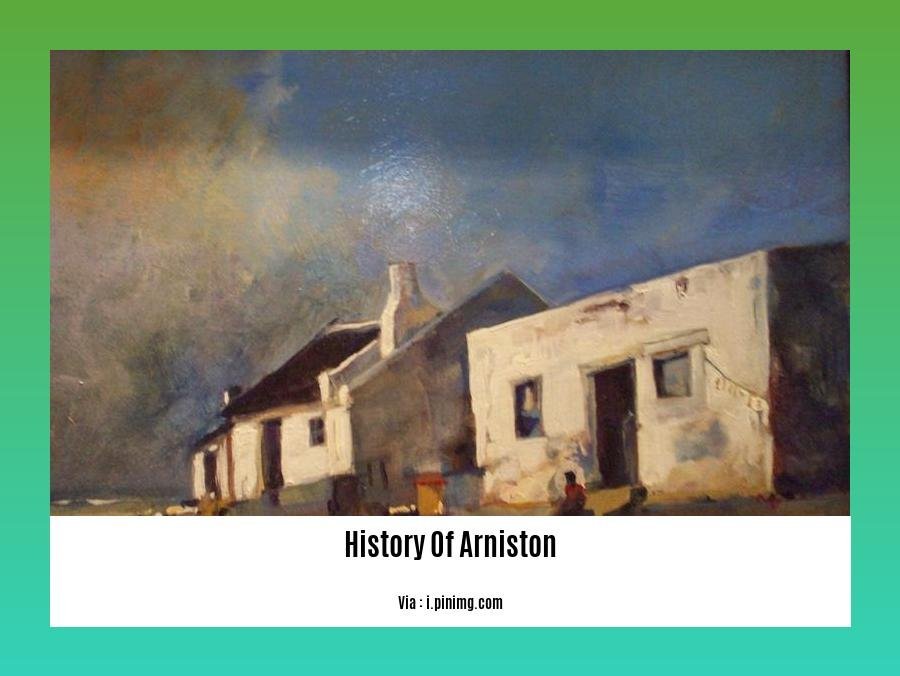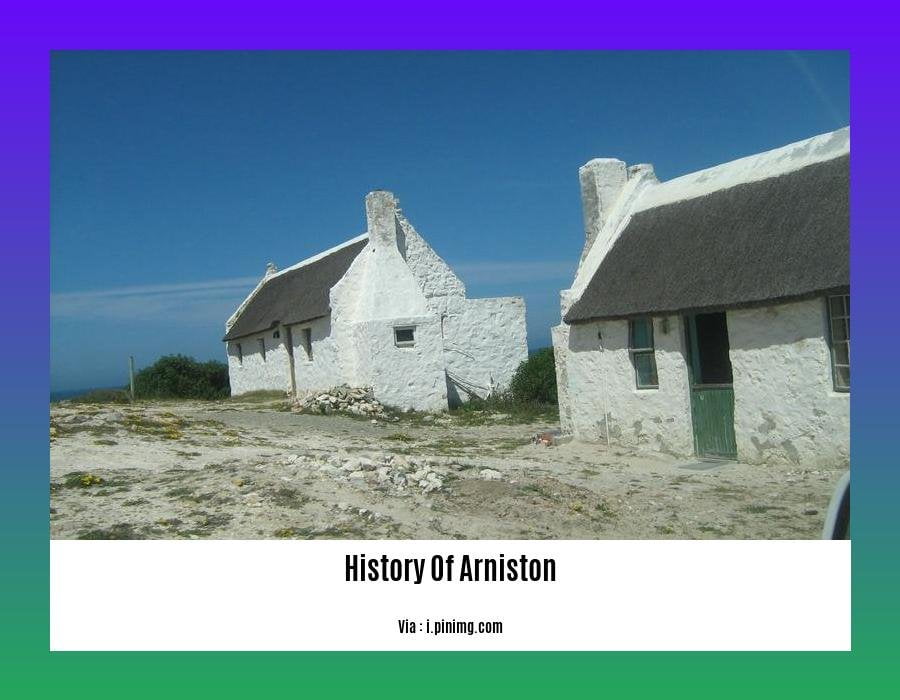– A Journey Through the Tapestry of Time: The History of Arniston –
Key Takeaways:
- The Arniston family played a significant role in shaping Scottish history.
- Arniston House, with its 450-year history, holds a wealth of valuable historical information.
- Meticulous analysis of primary sources and archival exploration reveals intriguing details about the Arniston estate and its inhabitants.
- Extensive study of medieval and early modern history enhances the understanding of this historic property.
History Of Arniston

Arniston, South Africa, boasts a rich history, beginning with nomadic hunter-gatherers. Its original name, Waenhuiskrans, derived from a cave large enough to fit a wagon. In 1922, Waenhuiskrans became Arniston, and the Fisherman’s Union was established in 1932.
One of Arniston’s most prominent features is Arniston House, a property with a 450-year history owned by the Dundas family. Its ancient ruins, archaeological excavations, and detailed historical records provide a unique window into the past.
Uncover the History Of Arniston’s fascinating chapters, from its ancient origins to the present day. Journey through time to experience the remarkable tapestry of this coastal town’s past.
Unveil the fascinating history of Arnis and discover the origins of this captivating martial art by delving into our comprehensive article on history of arnis. Delve into the rich tapestry of the history of Arnis Kali and Eskrima, uncovering the interconnectedness of these Filipino martial arts. For a concise overview, explore our article on history of Arnis Brainly to gain a deeper understanding of this vibrant cultural heritage.
Architectural Evolution of Arniston House
Embark on a captivating journey through the architectural evolution of Arniston House, a magnificent Georgian mansion that stands as a testament to its rich past. With its Palladian facade and elegant interiors, this architectural masterpiece has undergone a series of transformations, each reflecting the changing tastes and aspirations of its owners.
The Initial Vision
The genesis of Arniston House can be traced back to 1726, when Robert Dundas, Lord President of the Court of Session, commissioned renowned architect William Adam to design a grand country residence. The resulting structure showcased the classic Palladian style, characterized by its symmetrical proportions, central pediment, and intricate stonework.
Expansion and Refinement
In 1753, Robert’s son, John Adam, added the western third of the house, extending its grandeur and functionality. The addition harmoniously blended with the original design, preserving the Palladian aesthetic while introducing new elements of sophistication.
Restoration and Preservation
Over the centuries, Arniston House has undergone meticulous restoration efforts to maintain its architectural integrity. The interiors have been carefully preserved, showcasing the exquisite craftsmanship of the 18th century. The mansion’s stunning staircase, ornate plasterwork, and finely carved fireplaces are a testament to the artistry of the era.
Key Takeaways:
- The Architectural Evolution of Arniston House spans over 450 years, showcasing different architectural styles and periods.
- The initial design by William Adam in 1726 established the Palladian style, characterized by its symmetry and classical details.
- John Adam’s expansion in 1753 added to the grandeur of the house while maintaining its architectural cohesion.
- Restoration efforts have preserved the original features and interiors, ensuring the authenticity of the mansion’s historical character.
Citations:
The Gardens and Landscapes of Arniston

Nestled within the sun-drenched hills of Midlothias, Scotland, Arniston exudes an aura of timeless charm. Its sprawling gardens and meticulously manicured vistas are a living testament to centuries of horticultural artistry, inviting visitors to immerse themselves in a symphony of colors, scents, and tranquility.
Strolling through the sunken garden, one is enveloped by an ethereal beauty that echoes the past. This 18th-century sanctuary, a testament to the era’s love of informality, evokes a sense of whimsical enchantment. Lush borders overflow with a kaleidoscope of blooms, while ancient trees stand as silent guardians, their gnarled trunks whispering tales of by-Arniston centuries.
Beyond the sunken garden, the Arniston estate unfolds like a picturesque tapestry. Rolling lawns cascade down to the shimmering waters of the Firth of Forth, creating a breathtaking vista. Formal terraces, reminiscent of the Georgian era, offer panoramic views of the surrounding landscape, inviting contemplation and serenity.
The visionary minds behind Arniston’s horticultural masterpiece were none other than Sir Robert Dundas and his son Robert Dundas of Arnistoun, who engaged the services of Scotland’s most celebrated landscape architects, John Adam and William Adam, to transform their ancestral home into a horticultural haven.
Today, the Arniston gardens and landscape stand as a testament to their foresight and passion for beauty. Recognized as one of Scotland’s most significant historic gardens, they continue to be a source of inspiration and delight for visitors from near and far.
Key Takeaways:
- The Arniston gardens date back to the 18th century, exhibiting a blend of formal and whimsical styles.
- The sunken garden, an example of 18th-century informality, is a highlight of the estate.
- The formal terraces and rolling lawns offer breathtaking vistas of the surrounding landscape.
- Sir Robert Dundas and his son Robert Dundas of Arnistoun were the visionary forces behind the garden’s creation.
- The gardens remain a significant historic treasure, open to the public for exploration and artistic inspiration.
Relevant URL Sources:
- Arnistoun House Garden and Estate
- Arnistoun House
Arniston in the 19th and 20th Centuries
The 19th and 20th centuries unfolded as vibrant eras for Arniston, leaving indelible marks on both its architectural landscape and the lives of its inhabitants.
Expansion and Modernization
The heart of Arniston, Arniston House, underwent significant renovations during the 19th century. The western wing was extended, and the interior was lavishly refurbished to reflect the changing tastes of the time. The house became a showcase of Victorian opulence, boasting opulent furnishings and modern amenities.
Simultaneously, the town of Arniston, South Africa, evolved alongside its namesake estate. By the early 20th century, it had established a thriving fishing industry, which played a pivotal role in the town’s economic growth. The establishment of the Fisherman’s Union in 1932 further cemented the livelihood of the local fishing community.
The 19th Century
- Expansion of Arniston House, adding a western wing.
- Lavish interior refurbishment in Victorian style.
- Economic growth in Arniston, South Africa, driven by the fishing industry.
The 20th Century
- Establishment of the Fisherman’s Union in 1932.
- Arniston, South Africa, becomes a coastal holiday destination.
- Conservation efforts initiate, recognizing Arniston’s rich cultural and natural heritage.
Key Takeaways:
- Arniston House underwent extensive renovations in the 19th century, transforming its interior into a Victorian masterpiece.
- Arniston, South Africa, emerged as a thriving fishing town, with the Fisherman’s Union playing a crucial role.
- The 20th century marked the beginning of conservation efforts, preserving Arniston’s historical and ecological legacy.
Relevant URL Sources:
FAQ
Q1: What is the significance of Arniston House?
A1: Arniston House is a 450-year-old Georgian mansion, designed by renowned architect William Adam, that has played a significant role in Scottish history.
Q2: What led to the establishment of the town of Arniston in South Africa?
A2: The town of Arniston in South Africa was established in 1922 and named after the nearby Waenhuiskrans Cave and the HMS Arniston, a British East Indiaman vessel that wrecked on its shores in 1815.
Q3: What are some of the historical highlights of Arniston House?
A3: Arniston House boasts a rich history, including the addition of a western third by John Adam in 1753, its Palladian-style design, and its listing as a Category A historic building.
Q4: How far back does the history of Arniston extend?
A4: The history of Arniston in South Africa dates back nearly 2000 years, with evidence of nomadic hunter-gatherers in the region.
Q5: How did Arniston and Waenhuiskrans become the official town names?
A5: The town names Arniston and Waenhuiskrans were officially adopted in 1981, making it the only town in South Africa with two official names.















